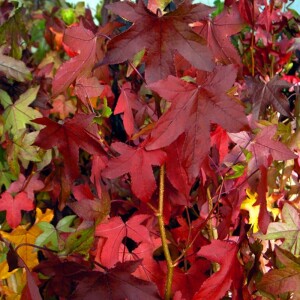 I was in the garden center last week, hot on the trail of colorful mums and half-price perennials when I laid eyes on something that made me forget both objects. It was a young, slender tree with some of the showiest fall foliage I have encountered—red, orange and purple, glowing in the late afternoon sun. The lobed, star-shaped leaves reminded me of a sweetgum or Liquidambar styraciflua, but the tree, though immature had a columnar shape rather than the usual pyramidal crown characteristic of traditional sweetgum varieties.
I was in the garden center last week, hot on the trail of colorful mums and half-price perennials when I laid eyes on something that made me forget both objects. It was a young, slender tree with some of the showiest fall foliage I have encountered—red, orange and purple, glowing in the late afternoon sun. The lobed, star-shaped leaves reminded me of a sweetgum or Liquidambar styraciflua, but the tree, though immature had a columnar shape rather than the usual pyramidal crown characteristic of traditional sweetgum varieties.
The label confirmed my suspicions. The tree was ‘Slender Silhouette’, a relatively new sweetgum variety that is occasionally billed as ‘Fastigiata’. It has all the charms of the species, but is much better adapted for smaller spaces, streetside locations and home gardens.
A species sweetgum is a big tree that can grow up to 75 feet tall, with a spread of about two thirds of its height. Its roots run wide and deep, making it most suitable for large areas like parks. The pale green flower clusters are not showy, but the glossy green leaves with their characteristic pointed tips, are beautiful throughout the growing season. Their fall farewell performance is magnificent and it is always a little sad when those brilliant leaves finally cascade to the ground.
Occasionally I have seen a sweetgum with star-shaped leaves that are rounded at the tips. This is Liquidambar styraciflua ‘Rotundifolia’, a variety of the native sweetgum. It is also a lovely tree with excellent fall color.
Autumn leaves are not the only things that sweetgums send cascading to the ground. Late in fall, the branches eject round, spiked capsules that look like small hedgehogs and require clean-up. If you like going barefoot among the trees, it is a good idea to avoid sweetgums, lest you run afoul of the sweetgum “balls”. Despite the handsomeness of the trees, some people refuse to plant them because of the issue with the fruits.
Sweetgums are native North American trees that are related to witch hazels. In the wild they prefer relatively moist locations. A fragrant gum or resin can be extracted from the bark of some sweetgums, which explains both the common and Latin generic names. “Liquidambar” is derived from two Latin words meaning “liquid” and “amber” or “resin”.
If you have admired traditional large sweet gum trees—or even if you have not—‘Slender Silhouette’ will be a revelation. It will grow tall, potentially reaching 50 feet in about 25 years, but will only spread six feet. The glorious fall color that I saw on the garden center specimen is characteristic of the variety. The tree has something for everyone, including gum ball haters, because it produces very few of the small spiky fruits. You will still have to clear away the fallen leaves, but will not risk turning your ankle when stepping on a fruit cluster hidden under a leaf accumulation.
‘Slender Silhouette’ is probably the result of a sport or spontaneous genetic mutation. It was discovered by Don Shadow, a renowned plantsman and introducer of new and exotic specimens, who owns a wholesale nursery in Tennessee. It often takes a lot of work propagate a sport vegetatively—from cuttings—and produce a stable variety that can be introduced into the horticultural marketplace. ‘Slender Silhouette’ passed that test and is widely available at good garden centers, usually in balled and burlapped form.
Depending on where you live, it can be either a little too late or the perfect time to plant a ‘Slender Silhouette’ sweetgum. If it is too late, but you want one anyway, mark your calendar or garden diary for early spring. If the time is right for planting in your climate zone, you can obtain this exceptionally beautiful, exceptionally svelte tree from ForestFarm, 14643 Watergap Rd. Williams, OR 97544; (541) 846-7269; www.forestfarm.com. Print catalog available.
